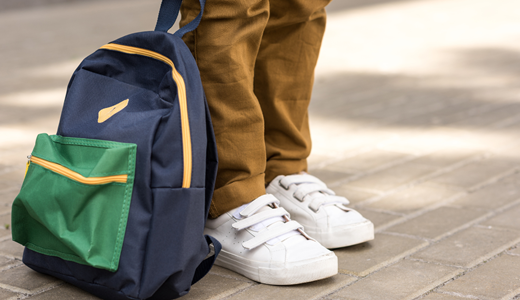It’s back-to-school time. That means school supplies. Pencils? Check. Erasers? Yup. Trapper Keepers? (Oh wait, it’s not the ’80s anymore. Oh wait again, they have new ones now? And vintage ones sell for big bucks? Who knew?)
Bulletproof backpack? Check.
Now, that sounds like something your teen might find while scavenging for useful gear in Fortnite. But it’s not. For the low, low price of $99, parents can now by a bulletproof panel to slide into their kids’ existing backpacks. The company that manufactures it, BulletSafe, says sales are up 40% since 2017. Or, as USA Today reports, just get a backpack already engineered for the same purpose. (The same company that makes those, Guard Dog Security, also makes bulletproof calendars for teachers.)
That concern, of course, is driven by the frequency of school shootings in the United States. A new study of mass shootings by the FBI and Texas State University found that of the 160 active shooter attacks between 2000 and 2013, about 25% occurred in schools (elementary, secondary, universities).
Trends like that one can leave parents feeling anxious and longing to do something that confers a sense of safety and control. But they still may not be as anxious and stressed out as teens themselves are these days. And naturally, it’s not just such obvious dangers that are making them fret. Utah’s Deseret News recently published an in-depth synthesis of the many factors contributing to teen anxiety these days. It examines how teens are struggling to balance technology, social media, relationships, and preparation for college and career—and the “fear of missing out,” or FOMO, that can come with having more options and information than ever before.
Speaking of acronyms, keeping up with evolving teen terminology and text-speak could probably be a full-job. “Lit,” for example, no longer means being intoxicated, but something that’s cool. And that’s just one of the word choices and acronym explanations you’ll find in Jennifer Jolly’s helpful USA Today article “‘It’s Lit’: The Ultimate Guide to Decoding Your Teen’s Text and Speak.” (Unfortunately, it’ll probably be outdated by the time you finish reading this blog.)
Elsewhere in teen news this week, many will no doubt be finishing up summer jobs as they head back to school. But perhaps fewer than we’ve seen in previous decades. National Public Radio reports that adolescents are increasingly eschewing those traditional summer jobs as lifeguards or pizza makers, joining the workforce later than ever. In 2000, 52% of teens had jobs. Today, that percentage has fallen to 35%.
Once school’s in session again, many kids will be relying on screens—both in the classroom and doing their homework on their own. But just how does digital engagement affect learning? In her extensive article “Do Students Lose Depth in Digital Reading,” Salon contributor Naomi Baron examines what science has to say about that question. Among other findings, researchers believe that screen-based reading encourages skimming and introduces the possibility of digital multitasking, both of which could potentially have a negative impact on memory, comprehension and critical thinking.
We never have to look too far to find news these days about what’s happening on screens, large and small. And this week is no exception. The media conglomerate Viacom reports that TV continues to retain its position at the top of the screen hierarchy, saying, “People use smaller screens only when they have to.” Then again, Viacom—the corporate owner of such “larger screen” entertainment properties such as MTV, BET, Comedy Central, Nickelodeon and Paramount—might have a vested interest in that assertion.
The Hollywood Reporter says, in contrast, that teen television consumption has been cut in half the last five years. Natalie Jarvey writes, “Generation Z is embracing digital entertainment at an unprecedented rate, representing a seismic generational shift in consumption habits that is radically transforming the media landscape.”
As reported last week, teens (and others) still tuning in to CW’s superhero shows this winter will meet a new LGBT hero, Batwoman, played by openly gay actress Ruby Rose (The Meg, Orange Is the New Black). Rose told late-night host Jimmy Fallon that the casting has been an emotional one for her: “I feel like the reason I kept getting so emotional is because growing up watching TV, I never saw somebody on TV that I could identify with, let alone a superhero.”
Still, the news hasn’t come without controversy. Surprisingly, however, criticism has come mostly from the far left, specifically some on social media who’ve said Rose isn’t “gay enough.” That criticism prompted the actress to leave Twitter.
If you’ve ever wondered when the Oscars were going to start rewarding popular films instead of dark indie movies no one’s ever seen, well, your wait is over. (We’ll be talking about this news in more depth in our Plugged In Vodcast later this week.)
And if you’ve ever wondered why the game show Family Feud is so full of sexual innuendo, well, you’re not alone. Former NCIS star Pauley Perrette ripped into the show on Twitter this week, tweeting, “Dear @FamilyFeudABC I love @SteveHarveyFM and I love game shows. WHY DO YOU MAKE YOU PROGRAM SO FILTHY? Even with child players? No reason.” She also wrote, “I’m a sociologist, love @FamilyFeudABC but WHY WHY are all the questions now filthy and sex questions? There’s so much more to humans. Cmon.”






Recent Comments